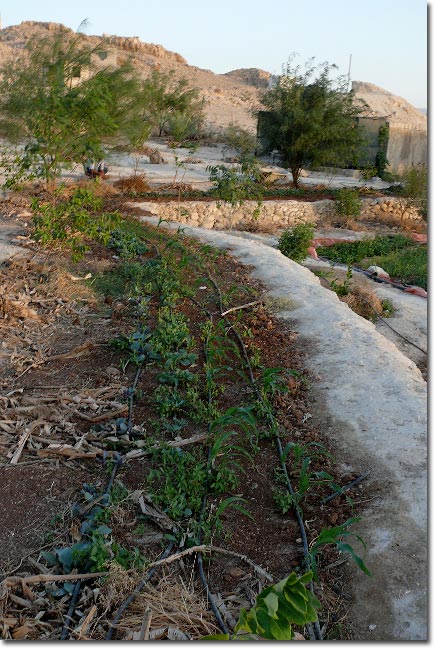
The Jordan Valley Permaculture Project (aka ‘Greening the Desert – the Sequel’) in Al Jawaseri in the Dead Sea Valley (lowest place on earth), continues to develop as we gradually fund the project into action with our own permaculture education programs, volunteers and funding from Muslim Aid Australia and Kids are Sweet of Wisconsin, USA. The male and female shower and compost toilet block is now reaching completion using a basic faralone design system (PDF, with others composting toilet resources here, here, here, here and here). A reed bed has just been built as part of the shower block waste water system so that we can demonstrate grey-water reuse for garden crops. A small nursery has been funded by one of the volunteers involved in this project, Damien McAnany, and it is now producing a selection of vegetable, fruit and tree seedlings. Damien organized his own fund-raising initiatives in the USA then volunteered for a few weeks on site. Other volunteers Jesse and Tanya Lemieux, Eric Seider, Wade Tait, Dave Spicer have all put in time and work to help push the project along. The trees planted on the site have just survived one of the hottest summers on record and are still growing well. The lower areas of the site now have quite extensive vegetable gardens which are coming into their first winter production.
Lime paste set for plastering straw bale and mud bricks |
The demonstration house which will include the multifunction infrastructure of a classroom, administration centre and student dormitories, is in its initial stage of construction with the main frame in concrete pillars and a roof on the first floor, second floor to be added later. We’re just starting to put in straw-bales to build the western wall and will be extending these onto the southern wall during a natural building course in early 2011. This course will include straw-bale and mud-brick building, the latter of which will be used for the northern and eastern cooler walls. The straw-bale walls will insulate and buffer the heat gain of the south and west with outside window shade and wooden shutters, the mud brick walls will bank the cool on the north and east with help of attached shading features also assisting garden productivity. The theme of this infrastructure is that we’re using the locally accepted concrete pillars and roof, which everyone understands and trusts, with a tiled, washable floor inside, but our infill will be done using natural building methods as an example of how effective these are if used with good design principles.
Straw bale ready for wall material in fill, with compost pile in foreground
Compost toilet under construction |
The western wall will be straw-bale with no windows (for full insulation) and the fully-shaded southern wall will have 2 windows and a door which will line up with the northern door – creating an exhaust/blow-through system. The fully shaded eastern wall will be mud-brick with 3 bedroom windows. The mud-brick on the eastern and southern walls will bank the cold, which will be insulated from the western sun in the afternoon and the southern sun during the day. The windows will be on the inside of the straw bale walls, allowing for shutters on the outside to insulate against extra heat gain and sun. and increase the effect of banking the cold temperature in the thermal mass of the east and south walls and the mud-brick internal walls. We will also be installing a cold air pipe coming 30 meters from the nursery up slope and buried 1 meter plus underground with solar chimney suction draw on the cold air and exhaust of accumulated warm air. Furthering our demonstration by using grey-water and “leaky pot irrigation” to extend water use through the gardens and fruit trees will be extremely valuable.
All of this is underway and there will be educational courses advertised on the website for February 2011 with the opportunity for people get involved in, and learn about, the construction. Moving forward, we will be employing a permanent caretaker on site and then will introduce small animal systems, including chickens, ducks, rabbits and pigeons. Once we have these manurial flows to direct we should be able to ramp up the productivity, especially as we will have a lot more tree shade and thus reduced evaporation by that stage.
We will continue to report in on our little rural/semi-urban project in the setting of the village of Al-Jawaseri in Jordan. Stay tuned.
Nadia on the plastering tools
Support species provide evaporation-reduction services (shade, wind-breaks),
nitrogen, insect predator habitat and diversity-enriched mulch
and compost material
Veggies